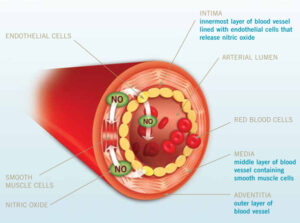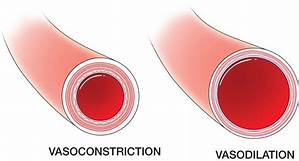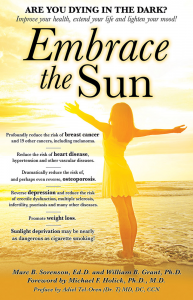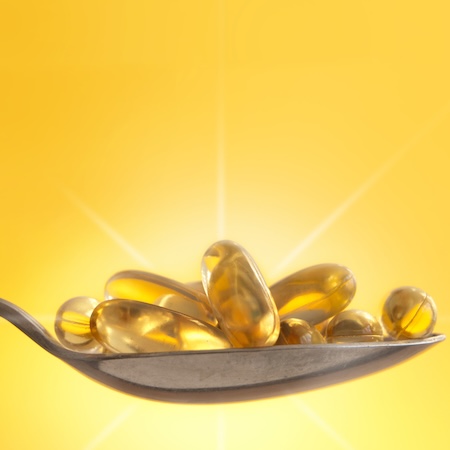Nitric oxide is colorless gas that produced by the stimulation of ultraviolet A (UVA) radiation to the skin. The raw materials for this gas are pre-formed stores of nitrates and nitrites. It is a potent vasodilator, and when released into the arteries, it causes increased blood flow in vessels. This lowers blood pressure, and as we have previously written, helps solve the problem of erectile dysfunction.
Of course, nitric oxide is not the photoproduct of sun that people generally think of when considering sunlight and its miracles. Still, bearing in mind its exceptional importance in heart and vascular disease, it certainly should receive more press.
Nevertheless, vitamin D, stimulated by the UVB portion of sunlight to skin, is the first photoproduct that comes to mind. Of course, vitamin D is often miraculous, but certainly not all encompassing. Yet, this focus on vitamin D may be unfortunate. This is because diseases such as hypertension and cardiovascular disease, (CVD) including stroke, are unaffected by vitamin D. Suppose that nitric oxide could profoundly reduce the risk of CVD, our number-one killer. According to Dr. Richard Weller, a scientist and pro-sun dermatologist, it is time for nitric oxide to receive its praise due to its ability to reduce CVD. Dr. Weller has stated, “Sunlight may have beneficial cardiovascular effects, independently of Vitamin D production. Vitamin D could, in these circumstances, act as a marker for sunlight exposure and its postulated beneficial effects.” One of those postulated beneficial effects is nitric oxide production, when UVA radiation touches the skin.
The profound influence on hypertension (high blood pressure) and CVD.
According to Dr. Weller, hypertension is the number-one risk factor for disability and life years lost. He states, “Epidemiological data show a correlation between increased sun exposure and reduced blood pressure and cardiovascular mortality.” Hypertension is a major factor for CVD. Weller then explains that sunlight is a risk factor for skin cancers, yet no link with increased all-cause mortality (death) exists. That could be due to increased vasodilation by nitric oxide, leading to lessened hypertension and subsequently, CVD. He makes a mistake, however, by saying “skin cancers,” because melanoma decreases with regular, non burning-sun. Nevertheless, the point is correct. The reduction in hypertension and CVD far exceed any increase occurring from skin cancer. Dr. Weller further explains, “The prevalence of cardiovascular and cerebrovascular deaths is 100 times higher than those from skin cancer.” For a thorough analysis regarding melanoma and sunlight, read, Embrace the Sun.
If nitric oxide saves lives due to vasodilation, and lowering hypertension, we should see fewer deaths from CVD in summer. Thus it is.
A study on seasonal variations in heart attack rates in Brazil demonstrated a higher risk in winter than summer in those aged 75 years and older. A Canadian investigation revealed that during the month of January there was an 18.6% higher death rate from heart attacks and a 19.9% higher death rate from stroke, in comparison with the month of September. Another study of sun exposure and stroke demonstrated that those who were least exposed to the sun were 61% more likely to experience a stroke. Nitric oxide could be a major operative mechanism for all of these results.
Therefore, to reduce the risk of CVD, soak up some non-burning sunlight, and its attendant nitric oxide.
For more information about nitric oxide, visit sunlightinstitute.org and read the book, Embrace the Sun.
Happy sunning!







